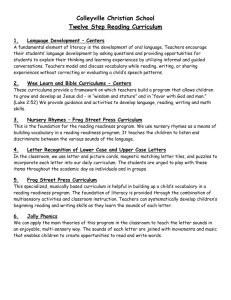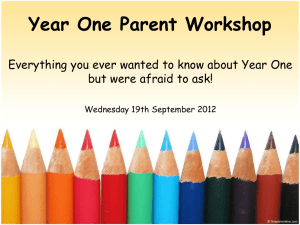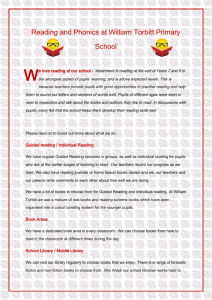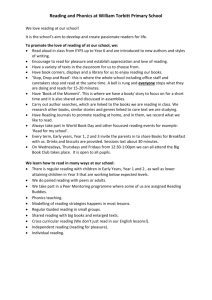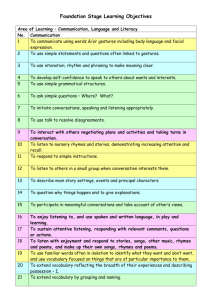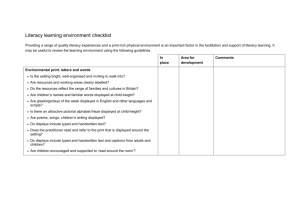the Reading and Phonics Powerpoint 25th August 2015
advertisement
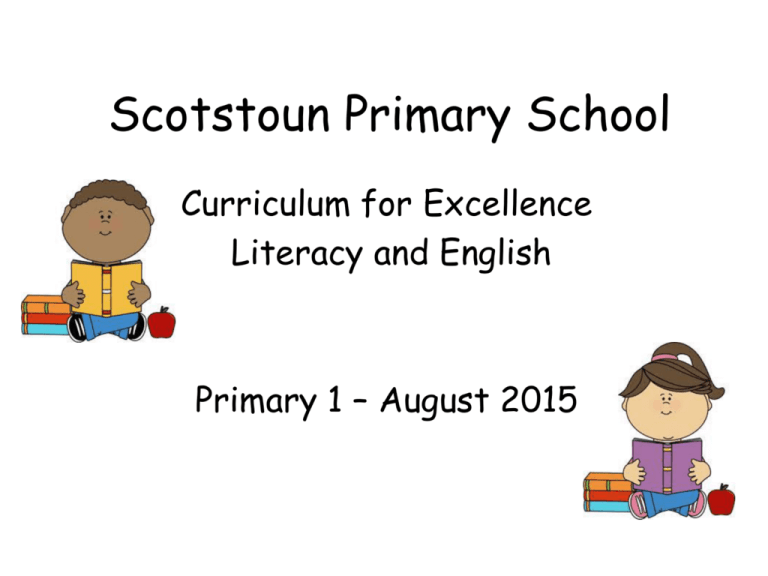
Scotstoun Primary School Curriculum for Excellence Literacy and English Primary 1 – August 2015 Literacy in P1 The teaching of literacy within a curriculum for excellence is divided into three organisers • listening and talking • reading • writing In Primary 1 we spend a large part of our day on literacy skills. Curriculum for Excellence levels • The curriculum is split in to levels ranging from early to fourth. • Pupils in Primary 1 will work on early level and some may be on first level by the end of the year. Reading Development Phonological Awareness – is the ability to listen and discriminate between the various sounds that make up language. Research indicates there is a correlation between a child’s phonological awareness and reading ability. Rhyming • The ability to recognize and produce rhyming words is an important phonological awareness skill. • Glasgow Dyslexia Support Service has developed a new rhyming pack to be used with all Primary 1 pupils. • Our Primary 1 pupils have begun developing their rhyming skills through the context of nursery rhymes. Nursery Rhymes • The children have been introduced to a different nursery rhyme every day. • The children are encouraged to join in with the rhyme. • The children are asked to identify the rhyming words. • The children are asked to give other examples of words that rhyme. Rhyming homework • Read the rhymes with your child and encourage them to join in. • As you read leave out the rhyming word and ask your child what comes next. • Reinforce by saying ‘well done ………….. rhymes with …………. • Play rhyming games – I’m thinking of a word that rhymes with ………….. Phonics • Phonics is a method of teaching young children to read and spell. • Children are taught to read and pronounce words by learning to associate letters or letter groups with the sounds they represent. • There are 26 letters in the English alphabet but over 40 speech sounds. Are you smarter than a 5 year old ? The Big Phonics Quiz The Big Phonic Quiz 1. 2. 3. 4. 5. 6. How many letters or combinations of letters make the long sound o ( as in “toe” ) in English ? What is a syllable ? How many syllables are there in the word pig ? What is a phoneme ? How many phonemes are there in the words – cat , chat , fish , stick and blue ? Identify the consonant blends in the words – fist , slip , shred and prod ? How well did you do ? 1. 2. 3. 4. 5. 6. 6 ways – “o” as in over , “oa” as in oatmeal , “oe” as in toe , “ow” as in blow , “o” plus a consonant and silent “e” as in bone and “ough” as in though. A syllable is a word or part of a word that contains one vowel sound. 1 A phoneme is the smallest unit of sound. Cat = 3 ( c , a , t ) Chat = 3 ( ch , a , t ) Fish = 3 ( f , i , sh ) Stick = 4 ( s , t , i , k ) Blue = 3 ( b , l, oo ) st in fist , sl in slip , shr in shred and pl in plod. Congratulations Jolly Phonics • Jolly Phonics is a resource we use in school to teach phonics. • It introduces the children to the letter sounds in an enjoyable way through the use of characters, stories, rhymes and actions. Learning the letter sounds • In Jolly Phonics the 42 sounds of the English Language are taught. • The sounds are in seven groups with some sounds written with two letters such as ee and or. • The letters are not introduced in alphabetical order. The first group ( s,a,t,i,p,n )have been chosen because they make more simple three letter words than any other six letters. In the classroom • Miss Bell – talk and demonstration of class activities. Phonics homework • Mrs Gough – talk and explanation of phonics homework. Word recognition As well as using phonic skills to help with reading, the children in Primary 1 are taught to recognise ‘character names’ and ‘common words’ The children are given a set of flashcards featuring the character names from our reading scheme. They should learn these at home. The children will also be given a set of flashcards of the common words to learn. Oxford Reading Tree In Primary 1 the pupils use a variety of reading materials from the Oxford Reading Tree. The scheme is divided into stages and most children in Primary 1 will start on Stage 1. Most of the children will be issued with a reading book after the October week. They will have each book for about a week. The children should be able to use their phonic knowledge to sound out the words in their reading books. Reading books • The children should bring their reading book to school everyday. • The children will have a reading marker which we ask you to comment on. • The teacher will use the marker to provide feedback on your child’s reading. • The reading book will not be the main focus of our teaching in school. • We will focus on teaching the children the tools and skills they need in order to be successful readers. Helping at home • Create a reading environment / time. • Listen to your child read or read the story to your child. Talk about the title, author, illustrator, pictures on the cover and inside the book. • Ask your child questions about the story. Try to ask a question that has the same answer as the text on the page. • Encourage your child to point to each word on the page as they read it. • Use the initial sound cards to try and make some of the simple cvc words from the story. • Use magnetic letters and make some of the cvc words from the story. • Play simple games like snap with the common word flashcards to help your child learn them. • Look for the common words in their reading book. • Try playing spelling tennis with the common words. • Use websites or Apps to play simple reading and phonic activities. Above all try to make the experience fun. Useful web sites for literacy • http://www.starfall.com – learn to read with phonics • http://www.kented.org.uk – literacy games • http://www.bbc.co.uk – literacy games ks1 • http://www.oxfordowl.co.uk – helping parents with their child’s reading at home and phonic pronounication.

